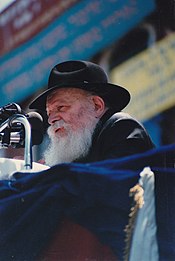3 Tammuz
| 3 Tammuz | |
|---|---|
 Rabbi M. M. Schneerson | |
| Observed by | Chabad-Lubavich community |
| Type | Commemoration |
| Significance | Yahrzeit (anniversary of the passing) of Rabbi Menachem Mendel Schneerson) |
| Date | 3 Tammuz |
| 2024 date | June 22 |
| 2025 date | July 9 |
| 2026 date | June 29 |
| 2027 date | June 18 |
| Frequency | Annual |
| First time | June 12, 1994 |
 |
| Part of a series on |
| Chabad |
|---|
| Rebbes |
|
| Places and landmarks |
| Holidays |
| Organizations |
| Schools |
| Texts |
| Practices and concepts |
| Chabad offshoots |
3 Tammuz or Gimmel Tammuz (Hebrew: גִּ׳ תַמּוּז, ɡˈɪmə͡l tˈamʌz lit. 'the third of Tammuz') is a holiday on the Chabad-Lubavich calendar that marks the anniversary of the death of Rabbi Menachem Mendel Schneerson, the seventh Rebbe of the Chabad-Lubavitch Hasidic dynasty. Schneerson died on June 12, 1994, corresponding to 3 Tamuz 5754[1] in the Hebrew calendar. The day is observed by followers of Chabad-Lubavitch as a time for reflection on his teachings and legacy.[2]
History
[edit]in the years leading up to his passing, Rabbi Schneerson experienced significant health challenges. In 1992, he suffered a stroke that impaired his physical abilities and limited his mobility.[3]
After his stroke, Rabbi Schneerson made limited public appearances, with his first post-stroke appearance occurring in May 1992. He was welcomed by his followers during this appearance at 770 Eastern Parkway his synagogue in Crown Heights, Brooklyn.[4] His ability to communicate remained, as he often sent written letters and recorded messages for special occasions, maintaining a connection with his community. Many of his followers continued to express their belief in his leadership and teachings, reflecting their ongoing dedication to his vision for the Jewish community.[5]
Rabbi Schneerson passed away on June 12, 1994, at the age of 92, marking the end of his physical presence within the Chabad-Lubavitch movement. His leadership continues to be recognized by the Chabad-Lubavitch community, and his teachings remain influential within the Jewish community[6][7]
Commemoration
[edit]
The anniversary of Rabbi Menachem Mendel Schneerson's passing on the 3rd of Tammuz is observed annually within the Chabad-Lubavitch community. Followers often visit his burial site, known as the Ohel, located in Queens, New York. It is customary for members of the movement to write a "pan" (a letter addressed to the Lubavicher Rebbe's gravesite)[8] with the belief that he remains spiritually alive and may respond to their requestsr.[5]
Chabad views Gimmel Tammuz as a holiday that commemorates Rabbi Schneerson rather than a sad day.[9] Thousands gather each year to pay tribute to his legacy and leadership.[10][11]
In addition to these pilgrimages, Chabad institutions and communities worldwide mark the occasion by organizing Farbrengens (gatherings). These events focus on Rabbi Schneerson’s teachings and contributions to Jewish thought, which continue to influence the Chabad movement.[12]
In addition to its significance related to Rabbi Menachem Mendel Schneerson, 3 Tammuz holds historical importance due to the events surrounding Rabbi Yosef Yitzchak Schneersohn, the sixth Rebbe of Chabad-Lubavitch, known as the Frierdiker Rebbe. On 3 Tammuz 5687 (July 12, 1927), the Frierdiker Rebbe was released from Soviet imprisonment. However, this date is not widely recognized as his full liberation, since he was only sent into exile in Kostroma at that time, and it wasn’t until 12–13 Tammuz that he received permission to return home.[13]
Origin
[edit]The observance of the holdiay traces its origins to the anniversary of passing) of Rabbi Yosef Yitzchak Schneersohn who passed away on January 28 1950 (10th of Av 5780). After his passing, Rabbi Menachem Mendel Schneerson, who succeeded him, emphasized the importance of this date in commemorating the legacy.[citation needed][14]
Rabbi Menachem Mendel Schneerson regularly visited the grave of his father-in-law, Rabbi Yosef Yitzchak Schneersohn to honor him.[15]
See also
[edit]- Tammuz (Hebrew month)
- 12-13 Tammuz
- Seventeenth of Tammuz
- Education and Sharing Day
- Chabad customs and holidays
- Maamarim (Chabad)
- Ohel (grave)
References
[edit]- ^ "Sun, 12 June 1994 = 3rd of Tamuz, 5754". hebcal.com.
- ^ "What to Do on 3 Tammuz".
- ^ "Stroke may be worse than first thought". northern california jewish bulletin. March 13, 1992. p. 37.
- ^ "Rebbe appears Ist time since suffering stroke". Northern California Jewish Bulletin. May 22, 1992. p. 41.
- ^ a b Heilman, Samuel (July 12, 2019). "The Chabad Rebbe died 25 years ago- here's how his movement has survived". Heritage Florida Jewish News.
- ^ "Tens of Thousands Mourn the Death of Rabbi Menachem Mendel Schneerson". Jewish Telegraphic Agency. June 13, 1994.
- ^ Goodstein, Laurie (June 13, 1994). "DEATH OF LUBAVITCHER LEADER, RABBI SCHNEERSON, STUNS FOLLOWERS". the washington post.
- ^ "Gimmel Tammuz: Observances, Resources". June 21, 2023.
- ^ "Finding Meaning in 3 Tammuz". COLlive. 2016-07-03. Retrieved 2024-10-15.
- ^ Weissman, Miri (July 9, 2024). "Thousands gather for 30-year yahrzeit of Lubavitcher Rebbe". Israel Hayom.
- ^ "Visiting the Lubavitcher Rebbe's Grave in Queens". Tablet Magazine. July 2, 2014.
- ^ "Live: Rabbi Yossi Paltiel Farbrengs for Gimmel Tammuz". June 22, 2023.
- ^ Johnson, Greg (June 25, 2010). "Remembering the Release of Rabbi Yosef Yitzchak Schneersohn". Resources For Life.
- ^ Zirkind, Dina. "10 Facts to Know About the Month of Av". Chabad.org.
- ^ "After 20 Years, Mourning for Chabad Rebbe Takes on Orderly Rhythm". The Forward. 2014-07-02. Retrieved 2024-10-15.
